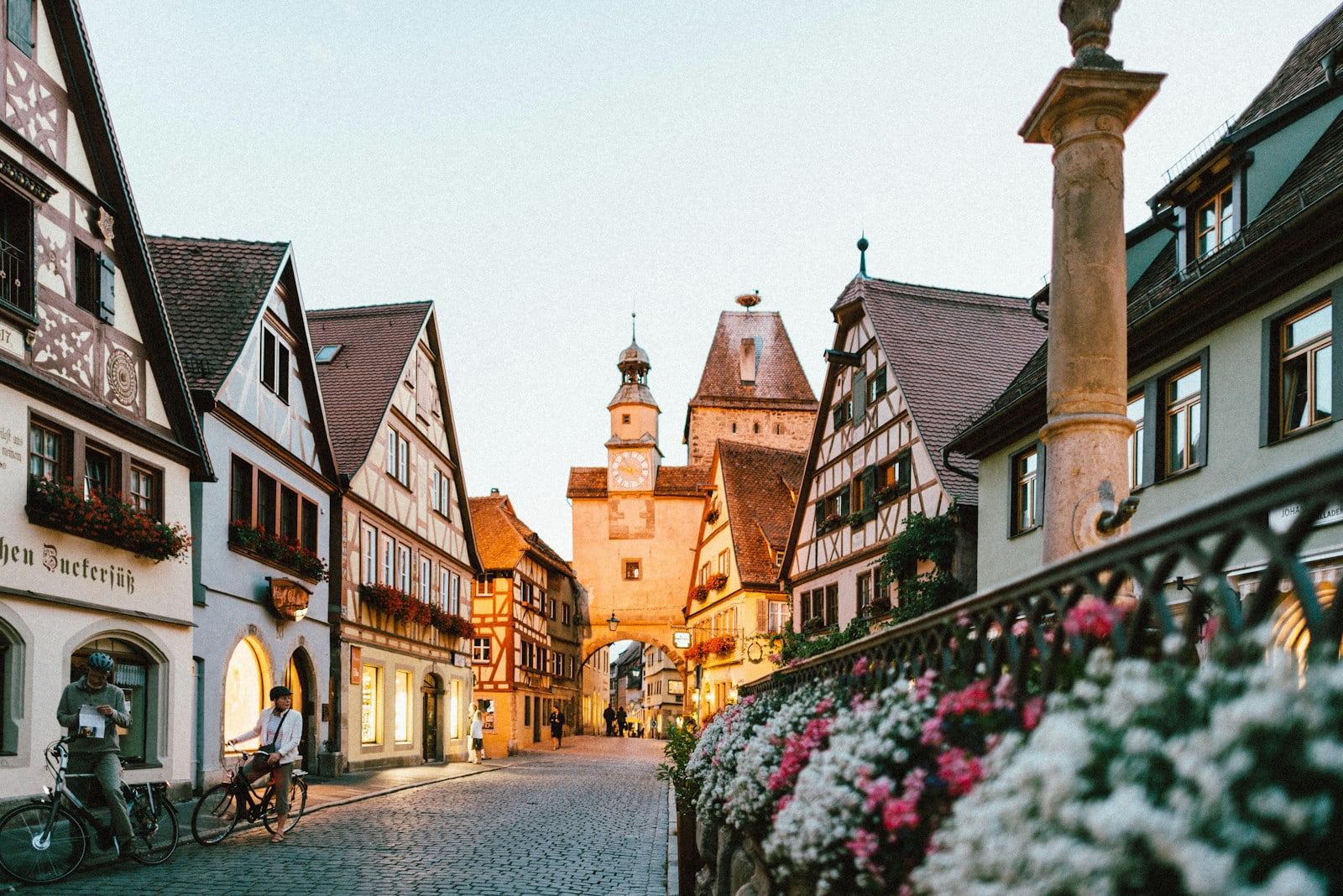Are you ready to dive into the captivating historical architecture of Düsseldorf? Step into a city that has seen empires rise and fall, survived devastating bombings, and played a vital role in Germany’s recovery.
As you explore its bustling streets, you’ll encounter architectural gems like the Collegiate Church of St Lambertus and the Stadtschloss.
But Düsseldorf is not just a city frozen in time; it is a vibrant metropolis with a thriving business center and a lively cultural scene.
So grab your camera and immerse yourself in Düsseldorf’s unique historical architecture.
Historical Architecture in Dusseldorf
Discover the impressive historical architecture in Düsseldorf through its well-preserved landmarks and iconic buildings. The city is renowned for its rich architectural heritage, which is a testament to its vibrant history.
Influential architects have left their mark on Düsseldorf, creating structures that showcase their vision and skill. One such landmark is the Stadtschloss, the city castle, which housed a vast art gallery during Johann Wilhelm II’s reign. Despite experiencing destruction and poverty after the Napoleonic Wars, Düsseldorf’s preservation efforts have ensured that many architectural treasures still stand today.
The Collegiate Church of St Lambertus is another famous landmark, known for its stunning Gothic architecture. The city’s commitment to preserving its historical buildings can also be seen in the Rhine Provinces parliament, which was established in Düsseldorf.
These architectural marvels not only serve as reminders of the city’s past but also contribute to its unique charm and character. As you explore Düsseldorf, take the time to appreciate the architectural wonders created by influential architects and the preservation efforts that have allowed them to endure.
Landmarks That Showcase Dusseldorf’s History
As you continue your exploration of Düsseldorf’s rich historical architecture, delve into the landmarks that showcase the city’s captivating history. One aspect that stands out is the architectural preservation efforts in Düsseldorf. The city has made significant strides in preserving its historical buildings, ensuring that they remain intact for future generations to appreciate. These efforts highlight the importance placed on maintaining the city’s cultural heritage.
Moreover, the influence of historical architecture on modern urban planning in Düsseldorf is evident. The city has seamlessly integrated its historical landmarks into its urban fabric, creating a harmonious blend of old and new. This integration not only adds character to the cityscape but also serves as a reminder of Düsseldorf’s rich past.
Some notable landmarks that showcase Düsseldorf’s history include the Collegiate Church of St Lambertus and the Stadtschloss (city castle). These iconic structures not only serve as architectural gems but also provide a glimpse into the city’s historical significance. Additionally, the Rhine Provinces parliament, established in Düsseldorf, is a testament to the city’s political and administrative importance throughout history.
The Impact of World War II on Dusseldorf’s Architecture
During World War II, the architecture of Düsseldorf was significantly impacted. The city experienced extensive damage due to strategic bombing campaigns, resulting in the destruction of many historical buildings and landmarks. However, in the aftermath of the war, Düsseldorf embarked on ambitious rebuilding efforts to restore its architectural heritage. While some structures were lost forever, there was a strong emphasis on architectural preservation, with the aim of preserving the city’s cultural identity.
The rebuilding efforts in Düsseldorf focused on recreating the city’s historical buildings and landmarks that had been destroyed during the war. Architects and city planners worked diligently to restore iconic structures such as the Stadtschloss (city castle) and the Collegiate Church of St Lambertus. These reconstruction projects aimed to not only rebuild the physical structures but also capture the essence and architectural style of the original buildings.
Architectural preservation played a crucial role in guiding the rebuilding process. Efforts were made to salvage and incorporate surviving elements of the destroyed buildings into the new structures. This approach ensured that the rebuilt architecture maintained a connection to Düsseldorf’s rich historical past.
Today, visitors to Düsseldorf can witness the successful outcome of these rebuilding efforts and architectural preservation. The city boasts a blend of historical and contemporary architecture, showcasing its resilience and commitment to preserving its cultural heritage. From the reconstructed landmarks to the carefully preserved facades, Düsseldorf’s architecture stands as a testament to its enduring spirit and the importance of architectural preservation in preserving a city’s identity.
Post-War Reconstruction and Economic Growth
After the ambitious rebuilding efforts to restore Düsseldorf’s architectural heritage following World War II, the city experienced significant economic growth. The post-war period saw a rapid transformation of Düsseldorf’s urban landscape, characterized by urban development and architectural preservation. The city’s reconstruction efforts weren’t only aimed at rebuilding the physical structures, but also at revitalizing the economy and improving the quality of life for its residents.
The economic growth of Düsseldorf during this period played a pivotal role in the post-war recovery of Germany. The city became an international business and financial center, attracting numerous companies and industries. Düsseldorf’s reputation as a fashion and trade fair hub further contributed to its economic success. The establishment of Messe Düsseldorf, which organizes premier trade shows, added to the city’s appeal as a global business destination.
The economic transformation of Düsseldorf guided the city’s development, with a focus on creating a vibrant and livable urban environment. Architectural preservation played a crucial role in maintaining the historical character of the city while accommodating modern needs. The integration of historical buildings with contemporary architecture created a unique blend of old and new, adding to the charm and appeal of the city.
Dusseldorf’s Livability and Cultural Influences
Continuing from the discussion on post-war reconstruction and economic growth, let’s delve into the livability and cultural influences that make Düsseldorf a vibrant and captivating city.
- The influence of Japanese culture is palpable in Düsseldorf, with its thriving Japanese community and authentic Japanese restaurants and shops. Walking through the streets, you can feel the fusion of German and Japanese traditions, creating a unique and enchanting atmosphere.
- Düsseldorf is also known for its dynamic electronic and experimental music scene. From underground clubs to large-scale festivals, the city pulsates with the beats of innovative musicians and DJs. Whether you’re a fan of techno, house, or avant-garde sounds, Düsseldorf offers a diverse range of venues and events to satisfy your musical cravings.
- The Rhenish Carnival celebrations in Düsseldorf are a riot of color, music, and laughter. Joining in the festivities, you’ll witness exuberant parades, elaborate costumes, and cheerful revelry that brings the whole city to life. It’s a time when the streets become a stage for joyous celebration, showcasing the city’s vibrant and inclusive spirit.
- With 22 institutions of higher education, Düsseldorf is a hub of intellectual curiosity and cultural diversity. From renowned universities to specialized academies, the city attracts students from all over the world, fostering a vibrant multicultural atmosphere that enriches the local community.
In Düsseldorf, the influence of Japanese culture, the thriving electronic/experimental music scene, the Rhenish Carnival celebrations, and the city’s diverse educational institutions all contribute to its livability and cultural richness. Whether you’re a resident or a visitor, these aspects make Düsseldorf an enticing destination that never fails to captivate.
Conclusion
So, what’re you waiting for? Take a trip to Düsseldorf and dive into its rich historical architecture.
Explore iconic landmarks, learn about the city’s resilience during World War II, and witness its remarkable post-war reconstruction.
Immerse yourself in the vibrant culture and lively atmosphere of this unique metropolis. Don’t miss the opportunity to capture the beauty of Düsseldorf with your camera.
Start your journey today and discover the captivating history that makes this city truly special.

Meet Henry, the history aficionado who’s dedicated to uncovering the stories of the past. He delves deep into the annals of history in every destination he visits, unearthing tales of ancient civilizations, legendary figures, and forgotten events. Henry’s passion for history breathes life into each place he explores, connecting the past with the present in a way that’s both captivating and enlightening. Join him on a voyage through time and unlock the secrets of our world’s rich heritage.

